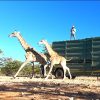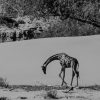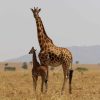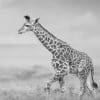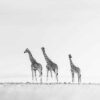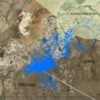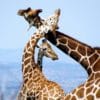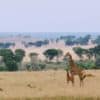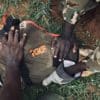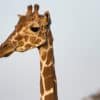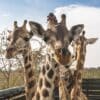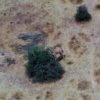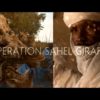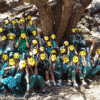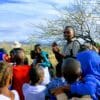The combined impacts of habitat loss, habitat fragmentation, habitat degradation, human population growth, poaching (illegal hunting), disease, and war and civil unrest threaten the remaining giraffe and their distribution throughout Africa. Many threats arise from direct, indirect or perceived competition for resources with humans and their livestock. Habitat degradation and loss is caused by an increasing human demand for agricultural land, pastoralism, and unsustainable timber and fuel-wood harvesting.
Human-giraffe conflict is not common, but can develop due to crop loss and damage, and potential disease transmission can result from habitat sharing with domestic livestock. The fragmentation and loss of giraffe habitat caused by human encroachment and infrastructure development often leads to the isolation of giraffe populations which, in turn, can limit the flow and exchange of genetic diversity between populations.
The interbreeding of giraffe species poses a potential threat as it could result in the loss of the genetic uniqueness of each individual species. Although there is essentially no evidence of species naturally interbreeding in the wild, the translocation of one species of giraffe to an area already occupied by a different species could create the risk of hybridisation –a situation that is already occurring in South Africa.
Limiting factors
The giraffe has a distinct advantage in that it seldom competes with other wild animals or, more importantly, domestic livestock for food. Although conflict does sometimes occur, they do not normally pose a threat to humans. Nevertheless, there are several factors that affect conservation initiatives throughout Africa.
Scientific
The existence of long-term studies, reliable historical and current data, and targeted conservation research concerning giraffe is limited. This lack of information remains one of the most limiting factors when it comes to improving their conservation and management, as well as their ecology and taxonomy. However, exciting advances are being made. GCF’s collaborative Africa-wide genetic research has unravelled the mystery surrounding the giraffe’s taxonomy, providing invaluable information for all four species’ future conservation and management. Some of the current projects and studies in Africa are the first ever to be undertaken of giraffe in their natural environments.
Conservation translocation projects can be highly beneficial for establishing new or bolstering small existing giraffe populations, but they are a significant and challenging logistical undertaking. Conservationists go to great lengths in their efforts to secure giraffe populations, and success has already been achieved in southern Africa and more recently in Kenya, Malawi, Niger and Uganda. Despite the logistical challenges, GCF’s conservation translocation programme, working closely with governments and other partners, has already increased and/or augmented over 7 million acres of giraffe habitat.
GPS satellite tracking units have become an important aid for understanding giraffe habitat use, post-translocation monitoring, seasonal movements, and home ranges, be they in and around human settlements or across international borders. The information these devices provide is invaluable for supporting long-term species and land management plans for giraffe and other wildlife. GCF’s Twiga Tracker initiative is the largest GPS satellite tracking programme ever conducted on giraffe. By understanding giraffe spatial ecology across Africa, GCF is developing innovative conservation strategies for protecting giraffe and their habitats. However, tracking giraffe using GPS satellite units require great investment in both time, innovation and resources; the cost of which is born largely by GCF and our partners. Additionally, the very nature of giraffe being such a uniquely built animal, this undertaking is something of a challenge!
Ecological
Giraffe populations naturally fluctuate due to mortality through predation and disease, and this varies from population to population. Lion are giraffe’s biggest natural predator. In some populations, lion are responsible for the mortality of more than 50% of calves in their first year. Giraffe are less vulnerable to leopard and spotted hyena and to an even lesser extent to cheetah and crocodile. Population growth is also limited by drought, which results in poor food quality and quantity and malnutrition, as well as diseases such as anthrax and, historically, rinderpest. Additionally, the poaching (illegal hunting) of giraffe by humans poses a threat throughout certain areas of their range.
Social
When it comes to conservation, giraffe compete with more charismatic species such as African elephant and rhinos, particularly for funding. It is estimated that the current giraffe population is only just over a third of the African savanna elephant’s. This discrepancy, and little-known fact by most in the world, leads many people to assume that giraffe are everywhere and do not face a conservation crisis – but the almost 30% population decline over the past three and a half decades clearly demonstrates that it does.

